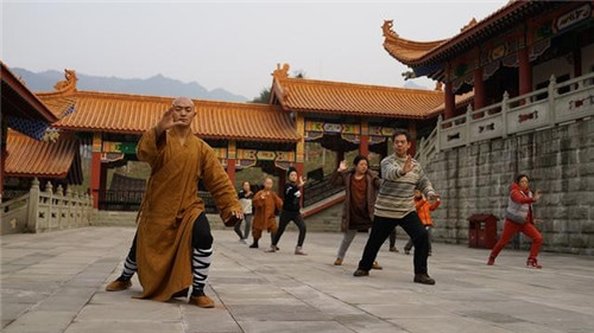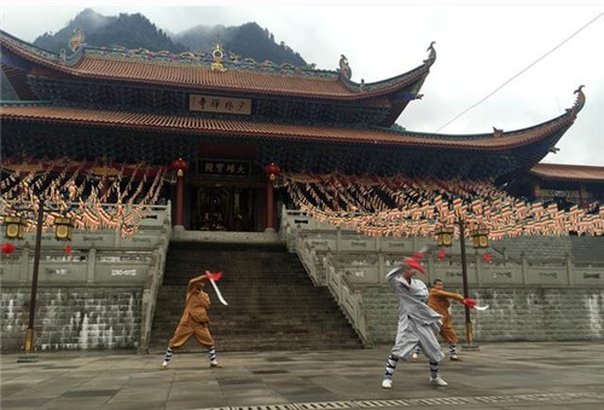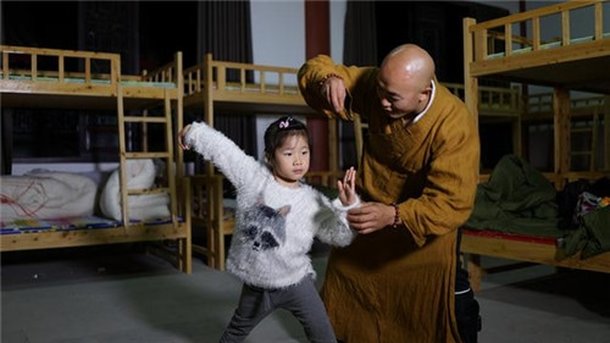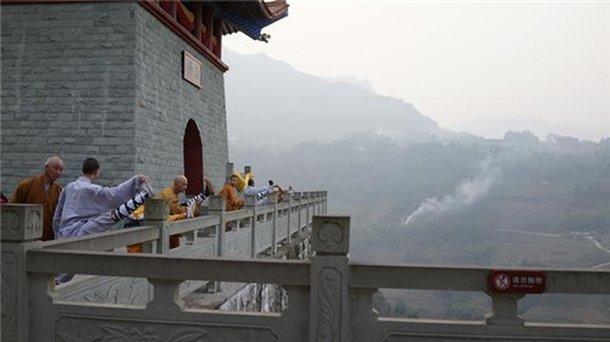New Shaolin Ch’an Temple in Chongqing
Original Chinese Language Article By: http://news.cnhubei.com
Article Provided by Mr Wang Ping (王平) - ICBI Office Beijing
(Translated by Adrian Chan-Wyles PhD)
Article Provided by Mr Wang Ping (王平) - ICBI Office Beijing
(Translated by Adrian Chan-Wyles PhD)
Translator’s Note: Master Xu Yun (1840-1959) was born at the ‘headquarters’ of the Quanzhou Prefecture, which is situated in Fujian province. In early 2016, China’s media reported on the progress of a ‘new’ Shaolin Temple being built in Chongqing (South-West) China (once part of Sichuan province), designed to spread the legitimate culture of Shaolin Ch’an meditation practice and martial development. This project appears to be a transmission primarily of the Shaolin Temple tradition that exists in Quanzhou, aided and abetted by the spiritual and historical might of the Songshan Shaolin Temple in Henan. What does this mean for the lay or monastic Ch’an practitioner? It means that a direct and true lineage of transmission must be present that conveys an authentic method of psychological and physical self-cultivation. Sit straight and do not wobble!
ACW 26.6.2017
The Fujian investors behind the new ‘Western’ Shaolin Ch’an Temple in the Jiangjin area of Chongqing, have stated that from the beginning to the end of this important spiritual and cultural project, the Shaolin Authorities at the Quanzhou Shaolin Temple (situated in Fujian province), have been fully consulted to ensure the authenticity and continuity of the well-known Shaolin Temple martial arts and Ch’an Buddhist traditions. This is particularly important, as the Shaolin Temple tradition is considered the birthplace of both Chinese Ch’an Buddhism in China, and of a distinctive spiritualised martial system. Its overall architectural style will be the combination of Southern Fujian architecture, combined with the characteristics of the Chongqing (South-West) building techniques, so that the red glazed brick common in Southern Fujian, will complement the black glazed bricks found in Chongqing. Quanzhou local media has reported that Shaolin monks from the area have assisted in the planning stages to create a firm foundation, and when fully completed, will assist the new temple to establish its martial and monastic routines, as well as cater for the visiting lay-Buddhist community. In addition, when fully completed, this new ‘Western’ Shaolin Temple will house ‘Buddha Relics’, and fully embrace all aspects of the ancient Shaolin Temple tradition, which include developing a sutra library, a fully functioning meditation hall, and a vibrant martial arts training syllabus. Eventually, when the cultural level has sufficiently developed and strengthened, Ch’an Buddhist monastics will be ordained at this temple. This will include not only direct contact with the Shaolin Temple at Quanzhou, but also with the oldest Shaolin Temple at Songshan (Henan). Visitors will be able to study the Buddhist sutras, sit for extended periods in the Ch’an Mediation Hall, and practice a number of Shaolin martial arts styles (taught by Shaolin monks) including Five Ancestor Fist (五祖拳 – Wu Zu Quan), Grand Ancestor Fist (太祖拳 – Tai Zu Quan), White Crane Fist (白鹤拳 – Bai He Quan), Plum Blossom Fist (梅花拳 – Mei Hua Quan), and Southern Fist Martial Arts (南拳功夫 – Nan Quan Gong Fu). As well as conveying the Caodong (曹洞) School of Chinese Ch’an Buddhism, the Shaolin Temple is also responsible for preserving and passing-on a fully developed and elaborate system of Chinese martial arts and related subjects (such as medicine and healing, etc). To ensure the correctness of transmission for these many important and precious Chinese cultural traditions, the Songshan Shaolin Temple has agreed to directly guide this process, a decision fully supported by the government of Mainland China, which has also assisted with finance and materials, declaring the project to be purely humanitarian and educational in nature, and strictly ‘not for profit’. This undertaking is part of a greater cultural project that values the self-discipline of mind and body to build psychological and physical strength and health, and in so doing, create a fully unified Buddhist culture in Mainland China that benefits the country, and by extension, the world.
ACW 26.6.2017
The Fujian investors behind the new ‘Western’ Shaolin Ch’an Temple in the Jiangjin area of Chongqing, have stated that from the beginning to the end of this important spiritual and cultural project, the Shaolin Authorities at the Quanzhou Shaolin Temple (situated in Fujian province), have been fully consulted to ensure the authenticity and continuity of the well-known Shaolin Temple martial arts and Ch’an Buddhist traditions. This is particularly important, as the Shaolin Temple tradition is considered the birthplace of both Chinese Ch’an Buddhism in China, and of a distinctive spiritualised martial system. Its overall architectural style will be the combination of Southern Fujian architecture, combined with the characteristics of the Chongqing (South-West) building techniques, so that the red glazed brick common in Southern Fujian, will complement the black glazed bricks found in Chongqing. Quanzhou local media has reported that Shaolin monks from the area have assisted in the planning stages to create a firm foundation, and when fully completed, will assist the new temple to establish its martial and monastic routines, as well as cater for the visiting lay-Buddhist community. In addition, when fully completed, this new ‘Western’ Shaolin Temple will house ‘Buddha Relics’, and fully embrace all aspects of the ancient Shaolin Temple tradition, which include developing a sutra library, a fully functioning meditation hall, and a vibrant martial arts training syllabus. Eventually, when the cultural level has sufficiently developed and strengthened, Ch’an Buddhist monastics will be ordained at this temple. This will include not only direct contact with the Shaolin Temple at Quanzhou, but also with the oldest Shaolin Temple at Songshan (Henan). Visitors will be able to study the Buddhist sutras, sit for extended periods in the Ch’an Mediation Hall, and practice a number of Shaolin martial arts styles (taught by Shaolin monks) including Five Ancestor Fist (五祖拳 – Wu Zu Quan), Grand Ancestor Fist (太祖拳 – Tai Zu Quan), White Crane Fist (白鹤拳 – Bai He Quan), Plum Blossom Fist (梅花拳 – Mei Hua Quan), and Southern Fist Martial Arts (南拳功夫 – Nan Quan Gong Fu). As well as conveying the Caodong (曹洞) School of Chinese Ch’an Buddhism, the Shaolin Temple is also responsible for preserving and passing-on a fully developed and elaborate system of Chinese martial arts and related subjects (such as medicine and healing, etc). To ensure the correctness of transmission for these many important and precious Chinese cultural traditions, the Songshan Shaolin Temple has agreed to directly guide this process, a decision fully supported by the government of Mainland China, which has also assisted with finance and materials, declaring the project to be purely humanitarian and educational in nature, and strictly ‘not for profit’. This undertaking is part of a greater cultural project that values the self-discipline of mind and body to build psychological and physical strength and health, and in so doing, create a fully unified Buddhist culture in Mainland China that benefits the country, and by extension, the world.
©opyright: Adrian Chan-Wyles (ShiDaDao) 2017.
Original Chinese Language Article: http://news.cnhubei.com/xw/gn/201602/t3545285_1.shtml
重庆西少林寺已经建成 系国内第四大少林禅宗寺院
2016-02-18 14:24:38
福建投资方称,重庆江津方面此前已多次前往泉州少林寺“取经”。“西部少林寺”将依托泉州少林寺,并充分挖掘其作为中国少林寺宗教、武术发祥地的资源。其整体建筑风格将融合闽南建筑和西南建筑的特色,让闽南的红砖琉璃瓦和西南的青砖黑瓦互相映衬。 泉州当地媒体报道,泉州少林寺方丈释常定已为“西部少林寺”奠基做法事。项目建成后,泉州少林寺还将派驻僧众进行事务管理。
除此之外,“西部少林寺”项目建成后,还将进行迎请佛骨舍利、引进少林寺佛教文化品牌等文化活动。届时,游客既可以在寺庙内参禅礼佛,还能欣赏少林僧人带来的五祖拳、太祖拳、白鹤拳、五梅花拳等南拳功夫。少林寺学武术是国内最权威武术学校,嵩山少林武术学校由河南少林寺主办,国家教育部门核准,非赢利性公立文武学校。承担少林寺武校招生,武术培训,而西部少林寺将和嵩山少林寺的成熟理念、佛学文化形成统一。



